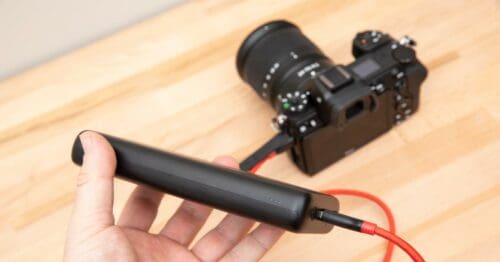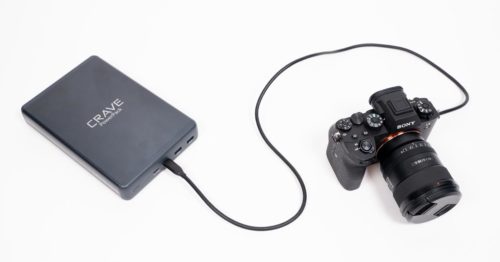Today I’m posting a quick review of the BioLite Charge 80 PD USB battery bank. A rugged 20,000 mAh rechargeable battery that has been keeping my cameras (and other things) charged on the road and in the field for the past few months.
As soon as modern mirrorless cameras became chargeable via USB-C, I fully embraced this idea and have written about it several times on this site while reviewing other USB power accessories. I love the convenience of being able to charge my cameras alongside my phone, headphones, headlamp and even my Mac laptop using a simple USB solution.
A few months ago I was approached by BioLite and asked if I would like to try out one of their new Charge PD battery banks to keep my camera gear charged while I was out in the field. The Charge PD is are available in three sizes: BioLite Charge PD 20, BioLite Charge PD 40 and BioLite Charge PD 80. These battery banks have capacities of 6,000 mAh, 10,000 mAh and 20,000 mAh respectively, and I immediately registered my interest to try the larger of the three capacities.
Video Overview
If you prefer to watch a video, here you go. And if you like the vid, please give it a thumbs up and subscribe to the channel, it really helps us out!
BioLite Charge 80 PD Features
- Capacity: 20,000 mAh, (74 Wh)
- Charge Time: 5 hours by 18W USB C-PD
- Weight: 465 g
- Dimensions: 6.7 x 3.2 x 1.0 in (170 x 82 x 25 mm)
- 1x USB-C PD port, up to 18W
- 2x USB-A Quick Charge 3.0 ports
- FAA Carry-On Compliant
- USB-A to USB-C cable included
Product Design and Ruggedness
BioLite is best known for their camping stoves, headlamps and camp lighting products. It’s no surprise then, that the BioLite Charge 80 PD USB battery bank has been designed with a mostly ruggedized rubber exterior that suits life in the outdoors a little more than some other battery bank products.
Overall, the pack feels solid and well put together, although I would have liked to see the rubberized finish encase the top section of the pack where the USB ports are located. While the main body of the battery does have a tough, non-slip rubber coating, the orange section surrounding the USB ports is regular hard plastic. After using the pack for a few months, I’d still say that it feels tougher than most other all-plastic USB battery packs, but the hard plastic section at the top does somewhat undermine the use of the rubber coating on the majority of the pack.
Competition
When I tried to find some equivalent rugged USB products on the market, the $69.95 price of the Charge 80 PD seemed just about right. You can pick up any number of basic 20,000 mAh battery banks from the likes of Anker on Amazon for $50. But for about $20 more, you are getting a really solid product from BioLite. If you want to get something even more rugged than the BioLite Charge, something with an IP67 waterproof rating, the price is going to jump up to around $120 for the GoalZero Venture 75.
Charging my Sony Cameras Over USB
At the moment I’m using a Sony a1 and a Sony a7S III. Both of these cameras use the Sony NP-FZ100 battery which has a 2,280 mAh capacity. Some quick math tells me that I should be able to recharge my camera somewhere around 8 times from the BioLite Charge PD 80 pack. Camera battery capacity doesn’t vary all that much between brands. For example, the Canon LP-E6NH that powers the Canon R5 and R6 has a capacity of 2,130 mAh. This means that whatever camera you are using, you can expect to get roughly the same number of recharges from a 20,000 mAh pack such as the PD 80.
In reality, I never used the PD 80 just for charging cameras. With 2x USB-A ports and a USB-C port, I usually had multiple things connected to it throughout a long day of shooting. Sometimes I would top up the camera directly, using the USB-C PD output, and sometimes I would connect my dual-battery NiteCore USN4 PRO charger to it, which will top up a pair of Sony NP-FZ100s simultaneously using Quick Charge 3.0.
Usually, I would have at least one other accessory connected to the pack, such as my Rode lav mics or my Rode VideoMic NTG. All chargeable over USB-C. When shooting video, my external 5″ HDMI monitor can also be powered by USB-C, and of course, my on-the-road laptop, a 13″ MacBook Air, can also be charged over USB-C PD. In fact, the BioLite Charge 80 PD has enough juice to completely recharge the laptop from empty. That will be useful when the world gets back to air travel again post-pandemic.
Charge Location
Living as I do in the Yukon, driving distances can be huge. I spend a lot of time in my car and usually keep a camera bag on the front passenger seat next to me with a camera and a long lens at the ready. After a few hours of shooting in one location, I usually top up batteries while driving to the next location. The battery simply lives in one of the padded slots in whatever camera bag I happen to be using that day, and I run a USB cable to the camera or other accessories. I never felt the Charge 80 pack getting hot when used this way.
You might ask why I don’t bother to charge things from the 12v plug in my car. The answer is that it’s not that easy to find a 12v plug with three outputs, especially one that has a USB-C Power Delivery port and a pair of QC 3.0 ports. If you do find one, you can expect to pay the majority of the price of the entire Charge 80 for it, and then you’d be constantly unplugging things from your car and plugging them into a battery in your bag. Charging everything from a single USB pack in my bag just keeps it simple!
Conclusion
A few years ago I used and reviewed the rugged Goal Zero Venture 30 battery pack. As more and more photography products became USB chargeable, I found that the Venture 30 no longer had the capacity I needed to keep everything topped up during a long day. I purchased a few different Anker battery packs after that, which got the job done, but since receiving the BioLite Charge 80 it has now taken over all my on-the-go charging duties.
The capacity to size ratio of this pack is just right. It’s large enough to charge cameras multiple times over multiple days, along with other peripherals such as microphones, headlamps, my phone and my wireless headphones. But it’s not so heavy that I want to leave it at home every time I pack for an overnight camping trip, or a long day hike.
When comparing this pack to the many other 20,000 mAh battery packs on the market, the standout features that should be noted are the 18W Power Delivery USB-C port and the use of the Quick Charge 3.0 protocol on the USB-A ports. QC 3.0 is important to activate fast charging modes in many Android devices, as well as activating the Fast Charging mode in my recommended NiteCore USB camera battery chargers.















